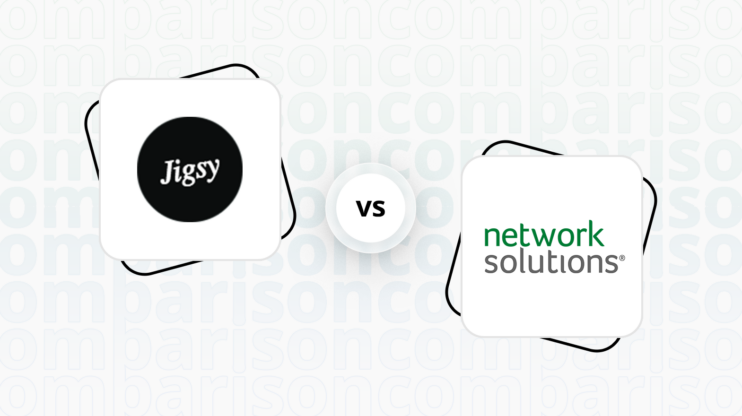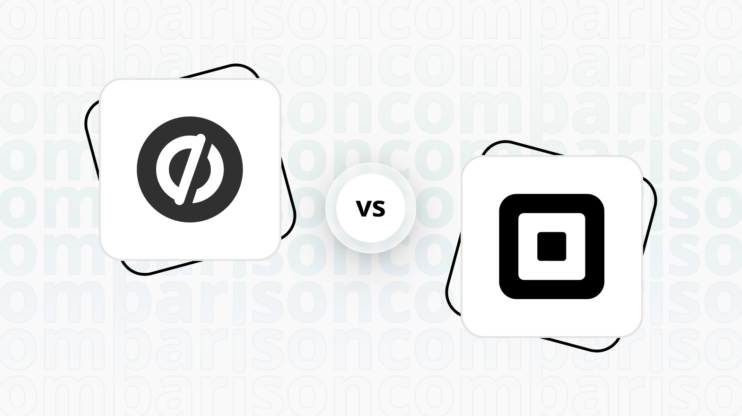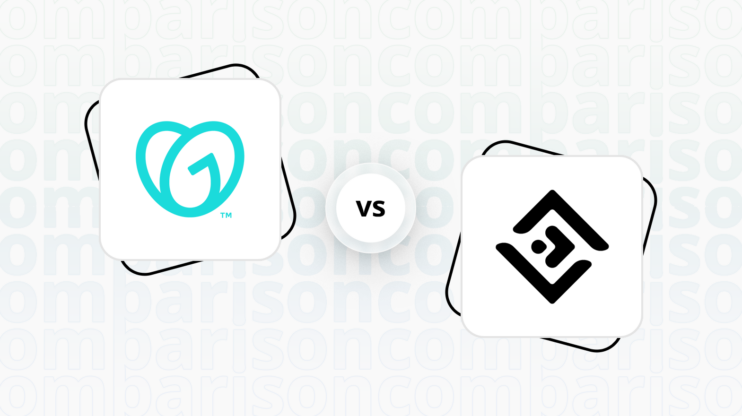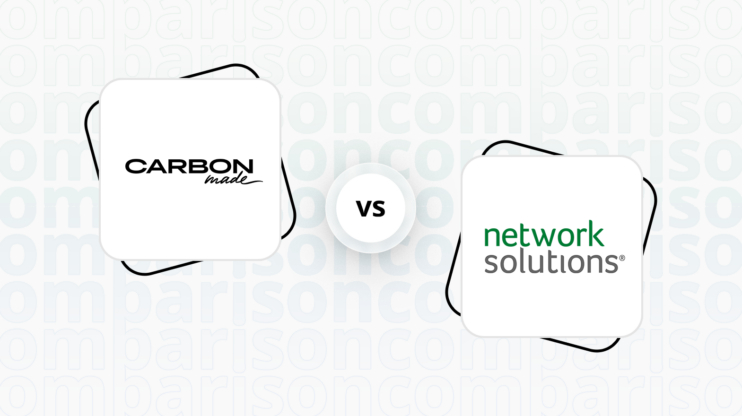Framer vs Web.com: Final verdict
Framer and Web.com both offer unique strengths, but they cater to different user needs and preferences.
-
Framer (Overall Grade: 7.1/10)
excels in design functionalities, AI capabilities, and website speed optimization. It is ideal for users who prioritize extensive customization, advanced design tools, and a modern, AI-driven approach to website building. Framer’s intuitive interface and comprehensive component library make it a strong choice for both novices and experienced designers. However, it lacks native ecommerce features and has a steeper learning curve for beginners. -
Web.com (Overall Grade: 5.8/10)
is a solid choice for users seeking a straightforward, no-code website builder with basic ecommerce capabilities. It offers a user-friendly drag-and-drop interface, mobile responsiveness, and essential SEO tools. Web.com is suitable for small businesses and individuals looking to establish an online presence without the need for advanced design or development skills. However, it falls short in terms of design flexibility, advanced features, and customer support compared to Framer.

|

|
|
|---|---|---|
|
Design functionalities & templates |
8.5 |
6.4 |
|
Ease of use |
7.1 |
6.4 |
|
Ecommerce |
5.9 |
6.3 |
|
Website Editors |
7.6 |
6.6 |
|
Product testing options |
6.2 |
0.2 |
|
Price |
7.7 |
7.4 |
|
Hosting quality |
7.1 |
5.9 |
|
Website speed optimization |
7.4 |
5.8 |
|
Plugins and integrations |
7.6 |
6.7 |
|
Marketing features |
7.2 |
7.0 |
|
Customer support |
5.6 |
7.3 |
|
Security |
8.2 |
7.6 |
|
AI capabilities |
7.6 |
7.3 |
|
User Management |
7.4 |
5.2 |
Which one is the best for ecommerce: Framer or Web.com?
 5.9
5.9
 6.3
6.3
Verdict
: Framer and Web.com offer different strengths in ecommerce, with Web.com slightly edging out Framer in overall ecommerce capabilities.
-
Framer
: Framer is a versatile website builder that integrates with platforms like Ecwid and Shopify for ecommerce functionalities. It offers a range of customizable templates and supports Stripe for payment processing. However, it lacks native ecommerce features, making it more suitable for users who need advanced design capabilities and are willing to integrate third-party ecommerce solutions. When comparing Framer vs Web.com, Framer scores 5.9 for ecommerce. -
Web.com
: Web.com provides a more comprehensive suite of ecommerce features, including product listing, marketing tools, and multiple payment gateway integrations. It offers a straightforward setup for online stores, although it has a limited variety of templates. Web.com is ideal for users looking for an all-in-one solution with built-in ecommerce capabilities. In the Framer vs Web.com comparison, Web.com scores 6.3 for ecommerce.
Which one is the best for informational and business websites?
 7.5
7.5
 6.5
6.5
Verdict
: Framer is the superior choice for informational business websites, offering advanced design functionalities and a user-friendly interface, while Web.com provides a more basic but reliable option.
-
Framer
: Framer excels with its AI-driven design and extensive customization options, making it ideal for users who want a highly personalized and visually appealing website. Its comprehensive component library and real-time collaboration features cater to both novices and experienced designers. With a score of 7.5, Framer stands out in the Framer vs Web.com comparison for its robust design capabilities and intuitive user interface. -
Web.com
: Web.com offers a straightforward platform with drag-and-drop functionality and a selection of pre-built templates, making it accessible for users without coding expertise. It emphasizes mobile responsiveness and includes basic eCommerce capabilities, making it suitable for small businesses. However, with a score of 6.5, it falls short in comparison to Framer in terms of design flexibility and advanced features.
Framer vs Web.com: Detailed comparison
Design functionalities & templates
Design FunctionalitiesRepresents how well each platform allows for creative design and customization of websites.Score Components:
- Template Variety (30%): Range and quality of design templates.
- Customization (30%): Flexibility and options for design alterations.
- User Interface (20%): Ease and intuitiveness of the design process.
- Responsiveness (10%): Adaptability to different devices and screen sizes.
- Innovation (10%): Unique design features and tools.
 8.5
8.5
 6.4
6.4
🏆
Winner: Framer.
Framer offers a more comprehensive range of design functionalities and templates, making it the preferred choice for users seeking extensive customization options and a diverse array of templates.
Framer offers a diverse array of over 1,000 customizable website templates and designs, catering to various industries and project requirements. It stands out for its robust design and prototyping features, including responsive design capabilities, real-time collaboration, and extensive import options from other design tools.

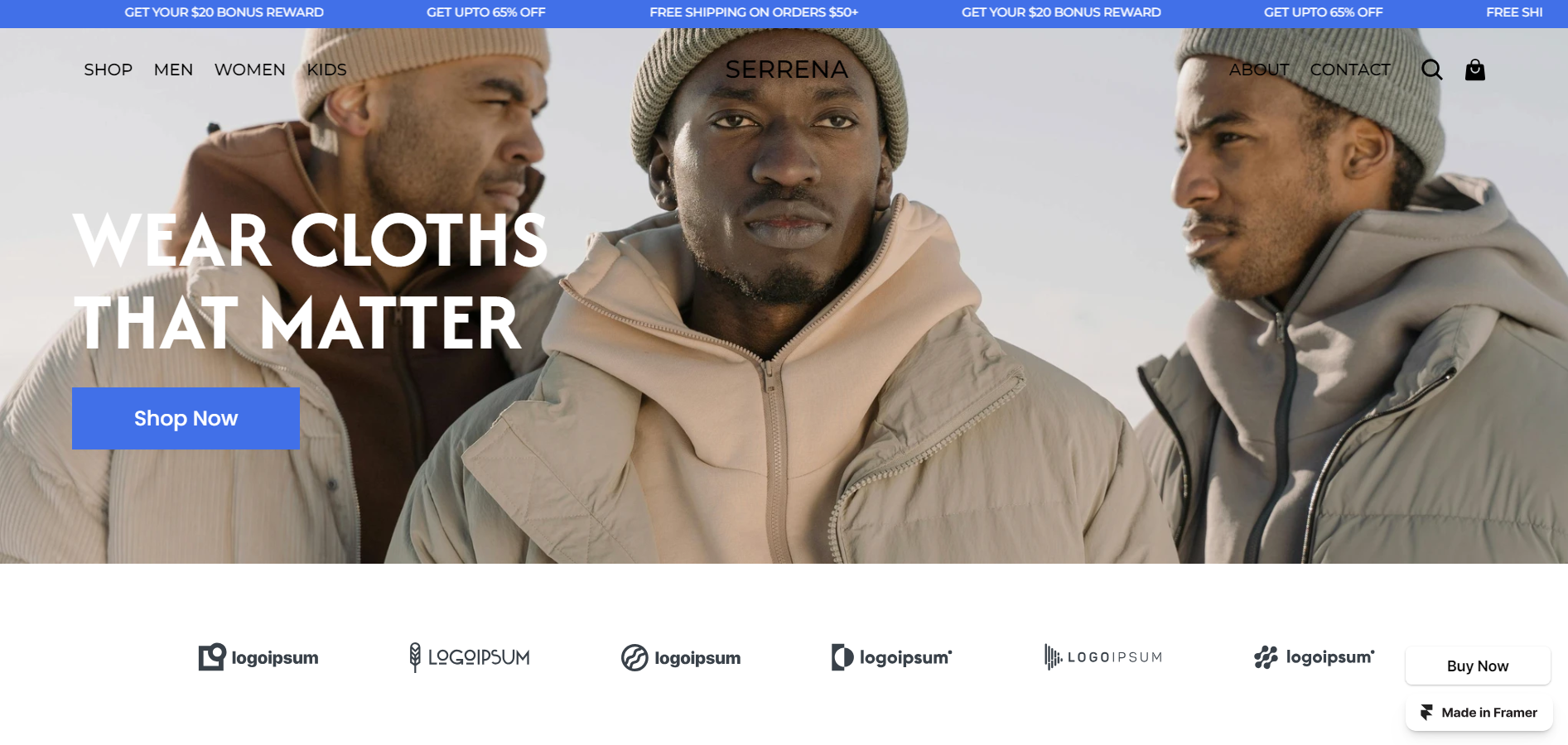
On the other hand, Web.com offers over 100 website templates designed to cater to a broad spectrum of industries and personalization needs. These templates are structured to be straightforward in customization, allowing users to easily adapt their chosen designs to suit their unique brand identity through the platform’s editor.
Get a head start on website creation with AI
Create a custom website tailored to your business needs 10X faster with 10Web AI Website Builder!
Ease of use
Ease of useReflects the platform’s overall user-friendliness.Score
Components:
- Learning curve (40%): Quickness and ease of getting started.
- Interface design (30%): Simplicity and intuitiveness of layout.
- User guidance (20%): Quality of tutorials and support.
- Flexibility (10%): Adaptability to various user skills.
 7.1
7.1
 6.4
6.4
🏆 Winner: Framer
. Scoring 7.1, Framer offers an intuitive user interface and AI-driven design, making it accessible for both novices and experienced designers. Web.com, with a score of 6.4, provides a platform aimed at those without coding expertise, but it might not be the best fit for those seeking quick, simple website setup.
Learning Resources
🏆 Winner: Framer
. Framer offers a wide range of learning resources for users at various skill levels, including detailed courses and lessons on Framer Academy. Web.com provides a range of AI-powered tools and a comprehensive knowledge base, but lacks a large community of users across various platforms.
For ecommerce
EcommerceMeasures the platform’s effectiveness in supporting online business activities.Score Components:
- Ecommerce themes and templates (20%): Variety and design of templates.
- Product management (25%): Ease of managing and organizing products.
- Payment options (25%): Variety and convenience of payment methods.
- Ecommerce features (20%): Features for managing an ecommerce store.
- Integration (10%): Compatibility with external e-commerce tools and services.
 5.9
5.9
 6.3
6.3
When it comes to ecommerce, Framer and Web.com offer different approaches. Framer does not offer native ecommerce features directly within its platform. Instead, it relies on integrations with platforms like Ecwid and Shopify. On the other hand, Web.com provides a suite of ecommerce features, including AI-driven design options, customizable templates, and secure payment solutions. However, it has been noted for its complex setup process and limited template variety.

|

|
|
|---|---|---|
|
Ecommerce themes and templates |
7.0 |
5.5 |
|
Product page customization |
5.5 |
6.0 |
|
Payment processing and commissions |
6.5 |
6.5 |
|
POS capabilities |
3.0 |
4.0 |
|
Payment gateways |
6.0 |
7.0 |
|
Product numbers |
6.0 |
5.0 |
|
Additional ecommerce features |
5.5 |
6.0 |
Framer ecommerce features:
- Ecwid integration
Web.com ecommerce features:
- Product listing
- Marketing Features
- Shipping options
- Payment Gateways integration
Ecommerce themes & templates
Framer offers 97 website templates specifically designed for ecommerce, providing a wide range of options for various business needs. These templates are highly customizable, allowing for easy adjustments to colors, fonts, layouts, and integration with essential ecommerce tools. Both free and paid options are available, catering to businesses of all sizes looking to enhance their online presence and sales capabilities.
Web.com provides around 15 ecommerce templates designed to help businesses quickly launch and customize their online stores. These templates are compatible with Web.com’s website builder, facilitating straightforward customization and integration for digital storefronts.
Product page customization
Framer primarily focuses on expanding design possibilities for ecommerce. However, it lacks inherent ecommerce functionalities and instead heavily depends on integrating with platforms such as Shopify and Ecwid. Additionally, while Framer allows for some customization of product pages, these modifications are generally limited to design and layout alterations.
Web.com’s website builder offers a suite of tools for e-commerce stores, including product category management for organizing inventory and improving navigation, and product listing features for adding detailed product information and images. Users can create and manage product variants to accommodate items with multiple options, enhancing the customer shopping experience.
Payment processing
Framer supports Stripe for payment processing, enabling a wide range of payment options including one-time payments, subscriptions, and more, without requiring coding. While specific transaction fees were not mentioned, such fees typically depend on Stripe’s pricing.
The Web.com website builder facilitates ecommerce activities by supporting popular payment gateways like PayPal, Stripe, and all major debit and credit cards, ensuring a wide array of payment options for customers. Details on transaction commissions, particularly whether Web.com imposes additional fees on transactions processed through these gateways, were not clearly stated in the reviewed sources. Typically, the payment gateways themselves may charge transaction fees; however, the presence of any supplementary commissions from Web.com remains unspecified.
Website Editors
Website EditorsEvaluates the platforms’ website building and editing capabilities.Score Components:
- Customization tools (40%): Range and power of editing features.
- Editor usability (30%): User experience within the editor.
- Design flexibility (20%): Freedom in layout and design changes.
- Update and maintenance ease (10%): Simplicity of updating and maintaining the site.
 7.6
7.6
 6.6
6.6
🏆
Winner: Framer
. Framer’s website builder editor, with a score of 7.6, is designed for high-fidelity prototyping and complex animations, catering to both designers and developers. It offers a robust set of tools for creating interactive and responsive designs, including a wide array of pre-built components, real-time collaboration features, and the ability to integrate with other design tools and workflows. Users can leverage Framer’s editor to craft detailed animations, fine-tune interactions, and test their designs across various screen sizes and devices. Additionally, its code export feature allows for seamless transition from design to development, making it a versatile choice for teams aiming to create polished, user-centric websites.
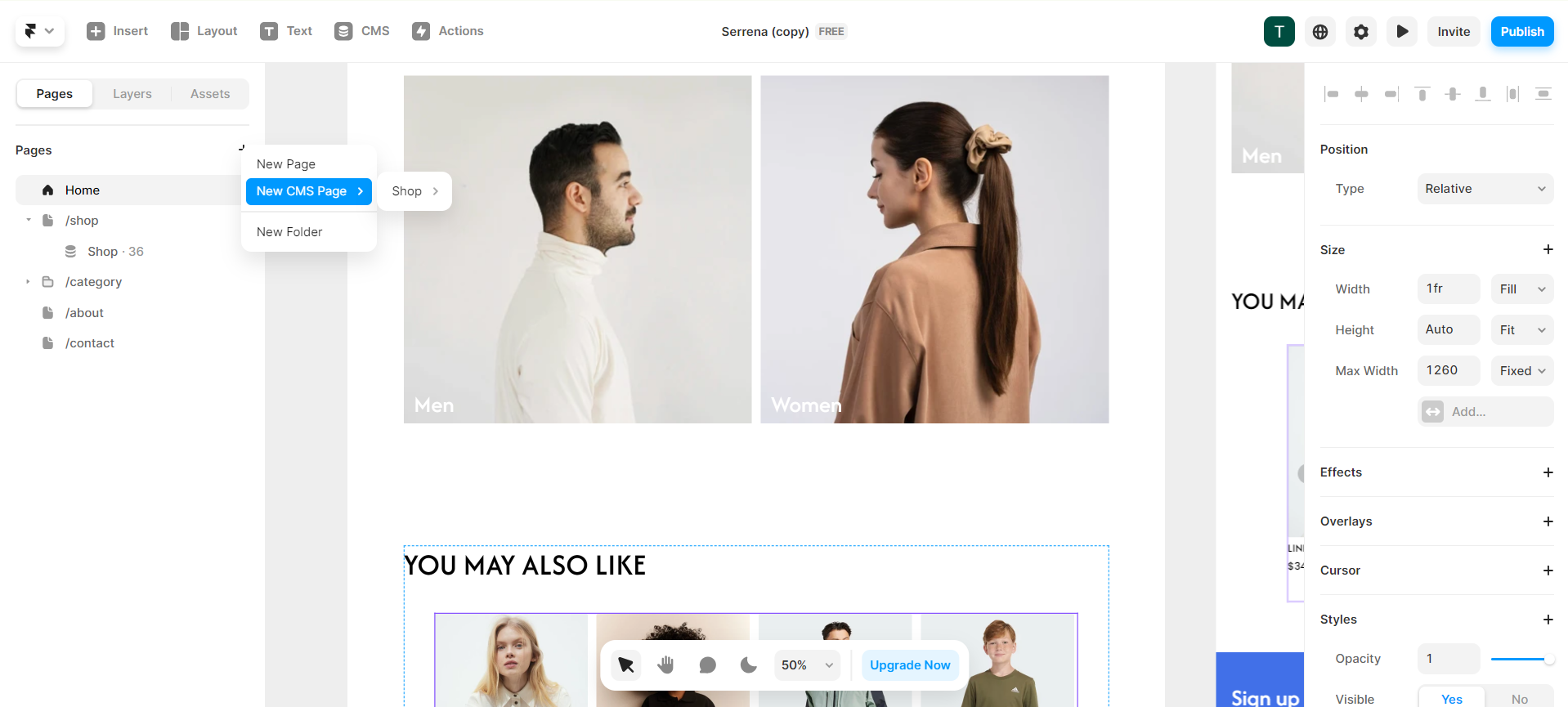
Web.com’s website builder, scoring 6.6, offers a user-friendly platform with a variety of templates and a drag-and-drop interface for easy customization, albeit with some creative limitations due to its row-based layout. It supports basic e-commerce capabilities suitable for small businesses, alongside features like analytics, social media integration, and email services. However, for more advanced functionalities like promotional pop-ups, calendars, or comprehensive blogging tools, the platform may fall short unless users are willing to add custom code.
Mobile editor/app
 4.5
4.5
 0
0
🏆
Winner: Framer
. Neither Framer nor Web.com offer a dedicated mobile editor app. However, Framer allows users to modify their website using a mobile browser, albeit with certain restrictions and inconveniences. This feature, despite its limitations, gives Framer an edge over Web.com, which does not provide any mobile editing capabilities. Therefore, Framer scores higher in this category.
Product testing options
Product Testing OptionsAssesses the options for trying out platform features before commitment.Score Components:
- Trial quality (40%): Extent and usefulness of the trial or free version.
- Feature accessibility (30%): How many features are available to test.
- Trial duration (20%): Length of the trial period.
- Ease of transition (10%): Smoothness of moving from trial to paid plans.
 6.2
6.2
 0.2
0.2
Overall Result
:
Framer Wins
. Framer scores 6.2 in product testing options, significantly higher than Web.com’s 0.2. Framer offers a free version and allows users to test some premium features, providing a more flexible testing environment. Web.com, however, does not offer a free or trial version, and users cannot test any features before purchasing a plan.

|

|
|
|---|---|---|
|
Free Plan |
Yes |
No |
|
Trial Duration |
No | No |
|
Testing Premium Features |
Some features with free version |
Not possible before purchasing a plan |
Price
PriceLooks at the cost-effectiveness and value for money of each platform.Score Components:
- Plan value (40%): What each pricing tier offers.
- Transparency and clarity (30%): Clearness of pricing structures.
- Flexibility of plans (20%): Range of options to suit different budgets.
- Hidden costs (10%): Additional expenses not included in the plan.
 7.7
7.7
 7.4
7.4
Framer and Web.com have similar price scores, but their offerings differ significantly. Framer offers a range of pricing plans that suit various project sizes and budgets, and provides a discount of 30 to 50% on annual billing depending on the plan. It also has an Enterprise Plan tailored for large-scale websites. On the other hand, Web.com offers a platform aimed at those without coding expertise, and provides up to 70% discounts on annual billing. However, it does not have enterprise plans for website building.
| Price range |

|

|
|---|---|---|
|
Free |
Free (Free/month): Allows 3 websites built on a framer.website subdomain with Framer branding in the footer. Limited to 1,000 traffic visitors and 1,000 CMS items. |
No offering at this amount. |
|
$0-$10 |
Mini ($10/month): Removes Framer branding, allows using a custom domain, includes collaboration with an additional cost for extra editors, custom code embedding, e-commerce support, and limited CMS items. Offers a monthly visitor limit of 2,000 and 1GB bandwidth. Value for price: 6.5 |
No offering at this amount. |
|
$15-$22 |
Basic ($20/month): Offers all Mini features plus increased limits for CMS items (1,000) and traffic (10,000 visitors per month), along with 10GB bandwidth. Value for price: 7.5 |
Website ($19.99/month): AI-powered Website Builder. Free domain & domain privacy for 1 year. Professional email for 3 months. SSL Certificate for 1 month. 1 hour expert design support. Social & email marketing tools. Value for price: 6.5 |
|
$20-$30 |
No offering at this amount. |
Website + Marketing ($24.99/month): All features in the Website plan. Enhanced marketing tools. Appointment scheduling. Value for price: 7.0 |
|
$30+ |
Pro ($30/month): Enhances Basic plan features with a significant increase in CMS items (10,000), traffic (100,000 visitors per month), and bandwidth (100GB), among other advanced features. Value for price: 8.5 |
eCommerce ($34.99/month): All features in the Website + Marketing plan. Online store with secure checkout. Sell on multiple marketplaces like Facebook, Instagram, Amazon, eBay, etc. Value for price: 8.5 |
location. As a result in rare cases the prices displayed here can differ from the ones you see on their
websites.
Hosting quality
Hosting
qualityExamines the reliability and performance of the hosting solutions.Score Components:
- Uptime (40%): Consistency and reliability of website availability.
- Speed (30%): Loading times and performance.
- Bandwidth and storage (20%): Sufficiency of resources provided.
- Data centers (10%): Quality and distribution of hosting infrastructure.
 7.1
7.1
 5.9
5.9
Winner: Framer
. Framer offers cloud hosting with a 99.9% uptime and a 99.99% uptime guarantee for enterprise plans. It has 4 data centers globally, providing reliable and efficient hosting services. On the other hand, Web.com offers shared hosting with unlimited storage and daily backups, but does not provide uptime statistics or guarantees, and does not disclose the locations of its data centers. This lack of transparency and guarantee gives Framer the edge in this category.

|

|
|
|---|---|---|
|
Do they offer hosting? |
Yes, included in all plans |
Yes, with unlimited storage and daily backups |
|
Data Centers: |
4 globally: 2 in US, 1 in Ireland, 1 in Singapore |
Not disclosed |
|
Type of hosting: |
Cloud Hosting |
Shared hosting |
|
Uptime: |
99.9% |
Not provided |
|
Uptime Guarantee: |
Only for enterprise plan, 99.99% |
Not provided |
Website Speed Optimization
Website Speed OptimizationEvaluates optimization of website loading timesScore Components:
- PageSpeed Score (30%): Google’s score indicating performance optimization.
- Loading Time (30%): The average time until a website is fully interactive.
- Mobile Optimization (15%): Optimization effectiveness for mobile devices.
- Resource Optimization (15%): Optimizing images, scripts, and other heavy resources.
- CDN Usage (10%): Use of CDN to enhance speed across geolocations.
 7.4
7.4
 5.8
5.8
🏆 Winner: Framer
Both Framer and Web.com have strategies in place for website speed optimization, but Framer has a higher website speed optimization score and places an emphasis on Core Web Vital improvements.

|

|
|
|---|---|---|
|
Focus |
Code Minification, Pre-Rendering, Caching, Image optimization |
Mobile Optimized design, Code Minification, Caching, Image Optimization |
|
Performance Tools |
Google Lighthouse, PageSpeed Insights |
Google PageSpeed Insights |
|
Key Strategies |
Code Minification, Pre-Rendering, Caching, Image optimization |
Mobile Optimized design, Code Minification, Caching, Image Optimization |
|
Load Times |
Varies depending on optimization and website complexity |
Varies depending on optimization and website complexity |
|
Page Speed Scores Range |
Varies depending on optimization and website complexity |
Varies depending on optimization and website complexity |
|
Core Web Vitals Improvement |
Emphasis on LCP, FID, CLS improvements |
No information provided |
Framer, with a website speed optimization score of 7.4, uses strategies such as code minification, pre-rendering, caching, and image optimization to enhance website speed. It also places an emphasis on improving Core Web Vitals, specifically LCP, FID, and CLS. However, the load times and PageSpeed scores can vary depending on the level of optimization and the complexity of the website.
On the other hand, Web.com, with a website speed optimization score of 5.8, also uses strategies such as mobile optimized design, code minification, caching, and image optimization. However, it does not provide any information on their Core Web Vitals improvements. Similar to Framer, the load times and PageSpeed scores can vary depending on the level of optimization and the complexity of the website.
Get a head start on website creation with AI
Create a custom website tailored to your business needs 10X faster with 10Web AI Website Builder!
Plugins and integrations
Plugins and integrationsMeasures the range and effectiveness of additional plugins and integrations.Score Components:
- Variety of options (40%): Range of available add-ons.
- Integration smoothness (30%): Ease of integrating plugins into the site.
- Quality of plugins (20%): Functionality and reliability of the options.
- Custom integration capabilities (10%): Support for custom or third-party integrations.
 7.6
7.6
 6.7
6.7
🏆 Winner: Framer.
With a score of 7.6, Framer offers a variety of plugins that cater to different needs such as forms, video & animation, social media integration, audio, and utility functions. These plugins enhance the functionality of websites created with Framer, allowing users to drag and drop these features onto their web pages, customize them, and connect them to their content or service.
On the other hand, Web.com, with a score of 6.7, provides a suite of plugins and integrations for websites built on its platform, including features for email marketing, social media engagement, analytics, and eCommerce capabilities. However, while basic features are included in Web.com’s various pricing plans, more sophisticated features or premium plugins might require an upgrade to higher-tier plans or involve additional fees.
Marketing Features
Design FunctionalitiesRepresents how well each platform allows for creative design and customization of websites.Score Components:
- Template Variety (30%): Range and quality of design templates.
- Customization (30%): Flexibility and options for design alterations.
- User Interface (20%): Ease and intuitiveness of the design process.
- Responsiveness (10%): Adaptability to different devices and screen sizes.
- Innovation (10%): Unique design features and tools.
 7.2
7.2
 7.0
7.0
🏆
Overall Winner: Framer
. Framer edges out Web.com with a slightly higher score, offering a comprehensive suite of marketing tools, including advanced SEO features, email marketing through Mailchimp integration, and robust analytics and reporting. However, it lacks built-in ads and promotions features. Web.com also offers a solid range of marketing tools, including basic analytics and reporting, and tiered marketing tools for ads and promotions.
| Marketing Features |

|

|
|---|---|---|
|
SEO Tools |
|
|
|
Email Marketing |
Through Mailchimp integration |
|
|
Blogging |
|
|
|
Social Media Integration |
|
|
|
Analytics and Reporting |
Only on higher plans |
Basic website analytics |
|
Ads and Promotions |
|
Tiered selection of marketing tools |
Customer Support
Customer supportEvaluates the quality and availability of support options.Score Components:
- Response time (40%): Speed of support responses.
- Support quality (30%): Effectiveness and helpfulness of the support.
- Availability (20%): Range of support channels (phone, chat, email).
- Resource richness (10%): Quality of self-help and educational materials.
 5.6
5.6
 7.3
7.3
🏆 Winner: Web.com
. In the Framer vs Web.com comparison, Web.com takes the lead with a higher customer support score of 7.3 compared to Framer’s 5.6. Web.com offers 24/7 support through email, live chat, and phone, ensuring users can get help whenever they need it. This round-the-clock availability is a significant advantage for users who may encounter issues at any time.
Framer, on the other hand, primarily relies on self-help options such as a community forum and a knowledge base. While users can email Framer’s support team, the lack of detailed information about their availability and working hours can be a drawback for those needing immediate assistance. Overall, Web.com’s comprehensive and accessible support options make it the better choice for customer support.
Security
SecurityLooks at the platforms’ security measures and data protection.Score Components:
- Data protection (40%): Safeguards for user and customer data.
- SSL and encryption (30%): Implementation of secure connections.
- Compliance (20%): Adherence to industry security standards.
- Regular updates (10%): Frequency of security updates and patches.
 8.2
8.2
 7.6
7.6
🏆
Winner: Framer
. Framer takes a comprehensive approach to security, utilizing Amazon Web Services (AWS) for hosting and ensuring data is encrypted at rest. They classify data into categories and manage secrets and encryption keys through AWS Parameter Store and Key Management Service (KMS). Access to secrets and keys is restricted based on the principle of least privilege, and environments are fully separated and isolated for additional security. Framer also emphasizes product security through secure development practices, external security testing, and a bug bounty program.
Web.com also offers a range of security services, including website staging environments and email solutions. They partner with SiteLock Security to provide cloud-based security services that scan websites for malware and vulnerabilities, automatically remove malicious content, and address potential security risks. However, Framer’s more comprehensive approach to security gives it the edge in this comparison.
AI Capabilities
AI capabilitiesMeasures the effectiveness of AI-driven features and tools.Score Components:
- Automation efficiency (40%): Impact of AI on streamlining processes.
- Personalization (30%): AI-driven customization for users or customers.
- AI-Assisted design (20%): Role of AI in website design and functionality.
- Data analysis (10%): Use of AI in interpreting user data and analytics.
 7.6
7.6
 7.3
7.3

|

|
|
|---|---|---|
|
Personalized Design |
Framer’s AI builder simplifies the process of creating and optimizing web content |
Web.com’s AI builder generates a stunning, ready-to-launch website aligned with the user’s business goals |
|
SEO Optimization |
|
|
|
Customer Behavior Analysis |
|
|
|
Sales Predictions |
|
|
|
Inventory Management |
|
Web.com’s AI e-commerce features include automated inventory management |
|
Content Generation |
Framer’s AI Translation offers a robust solution for global audience engagement by generating localized content |
Web.com’s AI Writer is a versatile tool for content creation |
🏆 Winner: Framer
. Framer, with a score of 7.6, utilizes AI mainly to enhance the design and content generation process. Its AI features focus on personalized design, content localization, and content optimization.
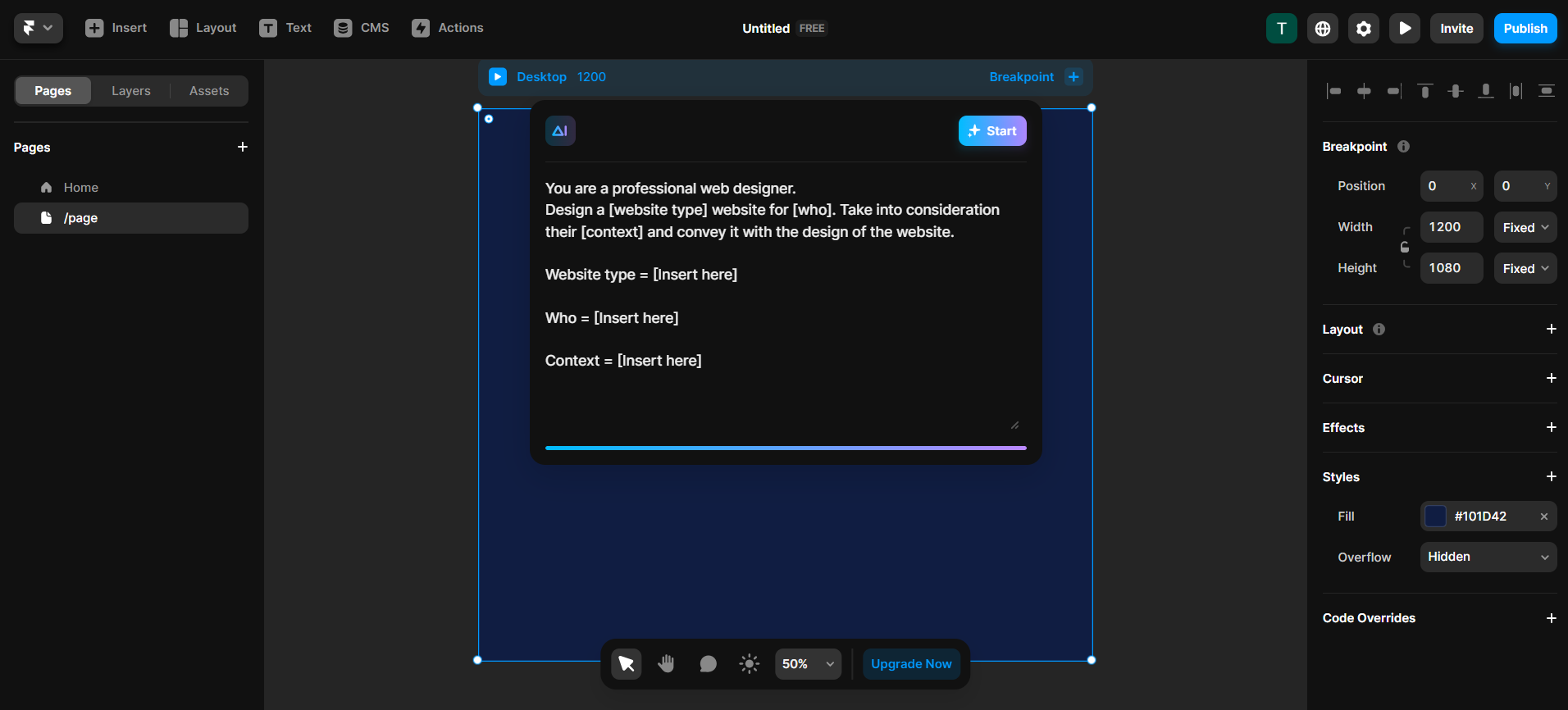
Web.com, scoring 7.3, uses AI to simplify the website creation process and enhance the e-commerce experience. Its AI features include personalized design, automated inventory management, and content generation.
User Management
User ManagementAssesses the platforms’ capabilities in managing user roles, permissions, and accessibility.Score Components:
- Role Customization (40%): Flexibility in creating and defining user roles and
permissions. - Ease of Management (30%): User interface and tools for managing users.
- Access Control (20%): Effectiveness of access control measures for different user
levels. - Scalability (10%): Ability to manage a growing number of users efficiently.
 7.4
7.4
 5.2
5.2
🏆 Winner: Framer
. Framer and Web.com both support team collaboration, but Framer provides more granular control over user roles and access levels.
- Framer supports team collaboration with different plans allowing a varying number of editors; the Team Basic plan allows up to 5 editors, while the Team Pro plan supports up to 10 editors. These plans come with additional features like live collaboration, comments, file storage, and extended version history.
- Web.com allows multiple user accounts, however the platform does not specify how many accounts are supported.
Framer User Roles and Access Levels:
| Role | Description | Access Highlights |
|---|---|---|
| Designer | Focuses on the aesthetic and UI/UX aspects of the website. | Can create and modify design elements, utilize animation libraries like Framer Motion, and implement accessibility settings. |
| Content Editor | Manages and curates content for the website, including text, images, and other media. | Can edit CMS content, use localization features for different regions, and modify SEO settings. |
| Developer | Works on more technical aspects, such as custom code and integrations. | Has access to deploy options, can use custom domains, manage project permissions, and apply custom code for further optimization. |
| Project Manager | Oversees the project, coordinating between different roles and ensuring the project meets its deadlines and goals. | Can invite collaborators, assign roles and permissions, and manage versions and rollbacks for efficient site management. |
| Collaborator (General) | A role that can encompass various levels of access based on project needs, including design, content, and deployment tasks. | Access can be customized to include a mix of design, content, and deploy permissions based on the project’s needs and the individual’s role within the team. |
Web.com User Roles and Access Levels:
| Role | Description | Access Highlights |
|---|---|---|
| Primary | The main account holder or primary user. | Edit primary user info Purchase products Manage and renew products and services |
| Admin | Users with administrative privileges besides the primary. | Edit payment information Add/Edit/Delete user roles Manage and renew products and services Edit WHOIS Admin and Tech user info |
| Tech | Users with technical responsibilities. | Manage and renew products and services Edit WHOIS Admin and Tech user info |
Additional Features

|

|
|
|---|---|---|
|
SSL Certificate |
|
|
|
Custom Domain |
|
|
|
Free Custom Domain Included |
|
|
|
International Domains |
|
|
|
Mobile Responsive |
|
|
|
Page Speed |
|
|
|
Website Builder Mobile App |
|
|
|
Convert a Website To An App |
|
|
|
Website Analytics |
|
|
|
Multilingual Sites |
|
|
|
Multiple Users |
|
|
Framer vs Web.com: User Feedback
Framer receives high marks for its user-friendly, no-code approach to web and prototype design, offering extensive tutorials, templates, and drag-and-drop functionalities that expedite the design process. Users appreciate its integration with tools like Figma, AI-generated responsive designs, and real-time collaboration features. Critiques focus on a steep learning curve for newcomers and limitations in customer support and features without premium access. Despite these drawbacks, Framer is lauded as a powerful design tool that enhances creativity and efficiency in web development.
Web.com, while providing a platform aimed at those without coding expertise, lacks detailed user feedback and G2 reviews. This absence of comprehensive user feedback makes it challenging to directly compare user satisfaction between Framer vs Web.com. However, Web.com emphasizes mobile responsiveness, eCommerce capabilities, and SEO tools, which are crucial for users looking to establish or enhance their online presence.
The making of this blog
We followed a clear, step-by-step process to write and research this article.
Framer vs Web.com: FAQ
Which platform is better for ecommerce, Framer or Web.com?
Can I create a professional informational website with Framer or Web.com?
How do Framer and Web.com compare in terms of design functionalities and templates?
Which platform offers better customer support, Framer or Web.com?
Are there any significant differences in AI capabilities between Framer and Web.com?
Which platform is more user-friendly for team collaboration and user management?
How do the additional features of Framer and Web.com compare?
What is the user feedback for Framer and Web.com?










